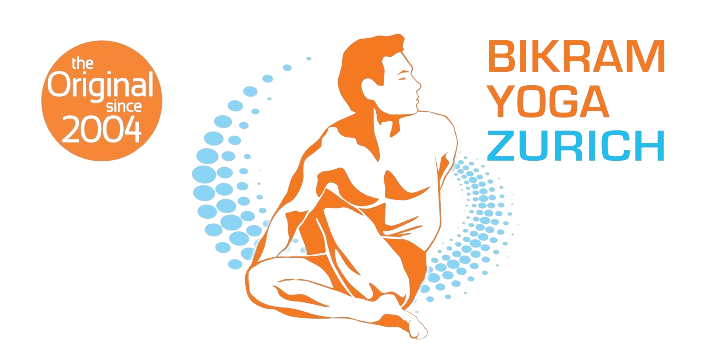Which 26 poses do we practice?
You would like to start with Bikram Yoga? Congratulations, your goal, at the age of eighty years is to be able to lace your shoes and to turn your head to change lanes driving your car. There are 26 poses selected from the 84 classic Hatha yoga asanas which help to achieve this goal.
The series is called Bikram Yoga, if practiced in the same sequence in a mirror walled room heated to 40°C with a slip-proof carpet floor and taught by a teacher certified by Bikram Choudhury himself.
The 26 poses start and finish with one breathing excercise. Also in Bikram Yoga we have short breaks of stillness between the poses to get the maximum health benefits of each pose.
Beginners are welcome in every class. They simply stand in the back row and try to follow each pose as much as they can. After regular practice, they can soon move up to the front row and be a role model for the beginners in the back row.
Bikram Yoga is taught in exactly the same way all over the world. This means that you can see the improvement in your body after each training session. This also has the advantage that the same thing awaits you in many other studios around the world.
Bikram Yoga stands for the same quality standards worldwide. The same experience, the same heat and of course, showers are always at your convenience.
The cleansing of your body, mind and soul will soon become a regular routine like taking a daily shower or brushing your teeth.
Based on a scientifically proven path to health, Bikram Yoga is known for its myriad medicinal benefits and its extraordinary ability to train and calm the mind.
The series of positions has a high therapeutic effect on all people, whether beginners or advanced. Indeed, those with injuries, out of shape, or those burdened with serious medical problems will be the first to experience the incredible effects of Bikram Yoga!
The 26 exercises work synergistically and constructively to ensure the total workout of every system in the body and to promote optimal health and well-being.
The set of exercises is designed as an incremental sequence so that each position warms up the muscles and joints that will be trained in the next position to allow the body to stretch safely and deeply. Bikram Yoga also stretches, presses and massages internal organs, flushes out the cardiovascular system and stimulates the hormonal and nervous systems.
By the end of class, each person is exercising every muscle, bone, joint, gland, internal organ as the fresh, oxygenated blood is pumped to every cell in the body. The result is the restoration of health in all areas.
Pranayama (Pranayama deep breathing)
The beginning of every Bikram yoga training: You breathe in warm air that warms your body from the inside and fills your blood with oxygen. You relax your shoulders and neck and are amazed by the strange sound of breathing that fills the whole room. You try to keep up with the rhythm of the teacher and your classmates and before you can think, you are already on the journey through your body in the here and now! You consciously perceive your breathing and notice that you no longer need to think because the teacher is guiding you word by word: the journey begins.
Ardha Chandrasana – Pada Hastasana (Half Moon with Pada Hastasana)
Feet together and arms above your head: You bend to the right and left and backwards and forwards. Your spine is warmed up.
Utkatasana (Squat position)
Now you build the foundation with a three-part exercise. This strengthens three different muscle groups. Your feet and especially your toes move freely, without shoes.
Garurasana (Eagle)
You stretch your wings and open all 14 main joints. You notice that the right arm has to be placed under the left arm. You press your legs and arms together until white spots appear. The blood starts moving and you massage the lymph glands. It is believed that this exercise makes you fertile.
Dandayamana – Janushirasana
(Standing head-to-knee position)
The fun begins: joint after joint is opened. You concentrate on the knee joint. The heat stretches the tendons and the back of the knee is opened so that the synovial fluid can wash around the entire cartilage, nourish it and rebuild it. Our bodies dry out as we age, as does the synovial fluid, which leaves behind salt crystals that rub away the cartilage. But not in Bikram Yoga, we simply dissolve them again. In this exercise you have to overcome your inner laziness.
Dandayamana – Dhanurasana (Bow Standing)
This is where all those who have never been able to live out their dream of ballet dancing will rave about. Balance on one leg is required, almost like the Denise Biellmann pirouette. You turn your spine sideways and the internal organs are moved from left to right and back again.
Tuladandasana (Libra)
Luckily, this exercise only takes 10 seconds, even if it sometimes takes 20: You make a table, as horizontal as possible, place your heart at the lowest point among all the organs and drive your pulse above the aerobic threshold.
Dandayamana - Bibhaktapada -Paschimotthanasana (Forehead-to-bottom)
You turn towards the side mirror and learn to keep your thigh muscle tense at all times so that the opposing muscle at the back is relieved. It takes patience to perhaps one day achieve the incredibly distant goal of "forehead to the ground".
Trikanasana (Triangle)
Actually the warrior pose, but in Bikram Yoga we want peace in the world and don't use such words. The heart and lungs are married. It is the most powerful exercise, trains all muscles and turns the spine sideways 90 degrees for the first time with force. You are now totally warmed up and the sweat is pouring.
Dandayamana – Bibhaktapada – Janushirasana
This cat's hump is a bit uncomfortable: it constricts your throat in order to express and supply blood to the five most important glands for hormone balance, fat burning and the immune system so that they can function fully again.
Tadasana (Tree)
This exercise opens the knee joints sideways and slowly your pulse calms down.
Padangustasana (Toe Stand)
The more you practice yoga, the faster you will be able to bend your knees so far that you can sit on your heels. Then you will know that you have healthy knee joints.
Savasana (Dead Position)
You deserve a break now, lie very still on your back, in your mind you feel like you are on the beach under palm trees. But your eyes stay open, you want to stay here and let your body heal. Up to now you have opened all your joints, shaken all your organs awake and supplied them with blood, you can feel your pulse and the warmth expands your blood vessels. A lot of oxygen reaches the furthest cell and ensures that the next cell division runs perfectly. This exercise opens the knee joints sideways and your pulse slowly calms down.
Pavanamuktasana (Belly Press)
Now you lubricate the hip joints at the back and massage the intestines for better digestion. You may feel a little pain in your hip because you are pulling your knee towards your stomach and at the same time stretching your spine so that the intervertebral discs are relieved.
Sit Up (Sitting Forward Bend)
A fresh energy boost between exercises: you renew the oxygen in your lungs and train your abdominal muscles at the same time.
Bhujangasana (Cobra)
Next comes the cobra series: four exercises to strengthen the long back muscle that keeps the spine upright. Don't forget to always keep your bottom tight, because that's where this back muscle is anchored. The cobra mainly strengthens the lower back.
Salabhasana (Half Grasshopper)
Ouch! Stretch your arms under your stomach, palms facing down. Now stretch your elbow, hand and finger joints. You're mainly working your upper back.
Poorna – Salabhasana (Whole Grasshopper)
Our flying exercise: You take off, fly as high as you can and imagine in your head how you are only using the middle part of your back muscle.
Dhanurasana (Bow Lying)
With the help of your legs you bend your spine backwards; you need a spine that has the resilience to absorb the blows with each step.
Supta – Vajrasana (Hero Position)
The knee joint is opened at the front and the ankles are stretched. You need a little courage to lie all the way back. You develop your self-confidence and you give your protected kidney a gentle massage.
Ardha – Kurmasana (Half Turtle)
The spine is stretched again, the shoulder joints in the upper area are opened, the brain is supplied with blood, the pineal gland is activated for better sleep and the frontal sinuses are cleared.
Ustrasana (Camel)
After 75 minutes of warmth, you can now attempt the deepest backward bend. You need a little courage at the beginning, but you can help yourself a little with your knees. The teacher is keeping a close eye on you here. You will be rewarded; this exercise opens the heart chakra, where the feelings are hidden. Slowly but surely, everything comes out and your inner light is switched on. This exercise simply makes your heart lighter and helps against depression.
Sasangasana (Rabbit)
No side of the spine is forgotten: Now bend forward as far as possible and try to relieve the pressure on your neck with a strong pull on your heels and bend your hollow back to the other side.
Janushirasana –Paschimotthanasana (Head-to-Knees)
Last chance to stretch your shortened Achilles tendon: It is responsible for your forehead not reaching your knee in the standing exercise.
Ardha – Matsyendrasana (Spinal Twist Pose)
The most important exercise at the end: you rotate your spine by 90 degrees. We use this pose as our logo worldwide. It activates all the nerve pathways that connect the brain with all parts of the body between each individual vertebra. It realigns your intervertebral discs. Bikram says: "With a good spine, you will have a good life."
Kapalbhati in Vajrasana
(Fire Breathing)
You did it! Now take another 120 short breaths, like blowing out a candle. The blood is enriched with oxygen. Then quickly turn over for the Savasana at the end.
Final Savasana
Two minutes at least! If you leave earlier, all your effort will have been for nothing, because you've worked hard for 90 minutes to reap the harvest. Recharge your batteries and enjoy this moment. Thanks to the Bikram exercises, you will automatically reach the deepest level of meditation (theta state). With other techniques, you need months of practice to achieve this.
Now you can dream, imagine that you are bursting with health and you can even make a wish to the universe. You relax completely, first your feet, legs, bottom - stomach, chest and shoulders - arms, hands and head - feel the "tingling" in your whole body - finally open your mind and your heart.
Namaste
How clever to descend into meditation with this wisely chosen mantra, meaning "The Spirit within me salutes the Spirit in you" - a knowing that we are all made from the same One Divine Consciousness.
Now you can close your eyes fly away, where ever you want, just follow the sunshine, where the sky is blue.
Slowly the first students begin to move, rolling up their mats leaving the room quietly, gentle, like new born babies, smiling with pink colored faces and full of courage to face the world outside.
In appreciation to Bikram Choudhury, Bishnu Ghosh and all the other great yogis dating back 5000 years to Lord Krishna, who passed on their knowledge generation by generation into our modern world.







